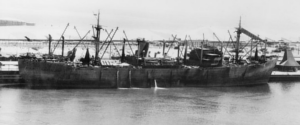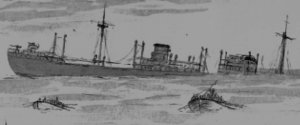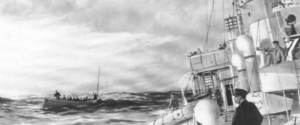

Walter leaning against Abbekerk’s 4″ gun. This picture – taken while in the Indian Ocean – survived because it was send home as postcard in april 1942
Mr. Walter MacNab, now age 92, was DEMS* gunner on Abbekerk during her last voyage. He found this website and contacted me. Walter still remembers his time on Abbekerk very well and I am very grateful for all the details that that fills in a lot of gaps in my fathers and Abbekerk’s story.
” For such a large vessel the defences were laughable and consisted only of two Oelikons, situated on either side of the Bridge, a “Four inch” gun on a raised platform on the after deck, (a so called anti-submarine gun), 6 Depth charges on either side of the rigging and 2 ‘stripped’ Lewis guns mounted on moveable tripods. The Lewis guns were manned by 4 DEMS gunners posted on board at Gourock, the others were manned by members of the crew, except for the last leg from Port of Spain to Liverpool when a Royal Navy gunner was posted on board to man the ‘Four Inch’ gun.”
Walter also remembers my father: ” I do remember your dad. He used to come up on deck after his shift in the engine room and sit on one of the hatches enjoying a long cool drink.”
While the ships crew had their work and their shifts to do I wondered if being a gunner was boring most of the time. But he told me they also had lookout watches on the bridge, but that is was boring most of the time anyway and poorly payed as well: “we earned extra cash by working in the officers’ mess as waiters and when in port as security guards on the gangways(..) whilst sailing, the Abbekerk was only attacked twice by aircraft — once by a Japanese spotter plane after setting sail for Australia and then outside Colombo when we fired at an unidentified plane, which failed to drop any flares signifying it was an allied plane. We were trained to shoot first and ask questions later!”
Since Abbekerk’s stay at Singapore and Oosthaven still surrounded by ‘mysteries’ I asked him what he remembered of those weeks early 1942.
” Yes, we were in Singapore about three weeks but I must honestly say I do not recall much bombing, probably because we were anchored far from the shore. Indeed we went ashore several times for a break from the ship and spent the night in the Toc H club. We also spent some time at the Raffles Hotel enjoying the dancing which was quite exotic compared to ship life! Perhaps we were just lucky! (..) What is certain is that one day, with many barges round the ship in various stages of loading, orders were given to stop loading, the ship’s pumps were turned on full blast and the barges were sunk. The hatches were shut and the ship made ready to depart but not before a batch of military come aboard. They were evacuated from Singapore because the Japanese had moved in to take over. They subsequently went ashore at Sumatra at the same time as Lt. North’s group. We did not sail in convoy from Singapore: the ship made off at full speed to avoid any problems with the Japs.
At Oosthaven we seemed to be waiting for further instructions. Some more unloading took place during which time we went ashore to have a look around and enjoy some local food as a change from ship rations. We did not sink any barges on this occasion.”
After Abbekerk was sunk Walter and the other DEMS gunners returned to England aboard a destroyer. He remained gunner on ships the rest of the war, but Abbekerk was to be his only ‘long voyage’: ” I sailed on several other ships as a Dems gunner before my trip on the Abbekerk but they were mostly short trips round the UK. I did not take any interest in their names — it was just routine work which had to be done and then we were off on another short trip. I spent a few months attached to a Pilot ship operating off the West coast of Scotland. This small vessel was being used in convoy assembly work. The seas were rough and I wondered at times how we managed to stay afloat but apart from the arduous conditions life was uneventful.”
I’m still in contact with Walter and I’m very glad for for all the time, the stories and information he is giving me!
Peter Kik
Zaandam, june 2009
I visited Walter late autumn 2009 in his house in Folkstone. It was a memorable day. We talked a lot about his live on Abbekerk and later when he was stationed ashore. I only stayed half a day and in retropect its amazing how he managed to tell all the story’s he did in the short time I was there.
Story’s about the cockroach infestation that they were unable to stop because they never stayed in port long enough for a thorough extermination cycle, thus creating a habit of always keeping food and drinks closed. About him running to battle stations on the bridge after the first torpedo hit, only to be thrown into the sea by the blast of the second torpedo. About the quite exhilarating way the survivors were transferred by lifeboat from the Wallflower to a Destroyer with neither vessel reducing speed. The tears in his eyes when he recalled being handed a letter from one of the soldiers that left Abbekerk at Sumatra. He delivered the letter to the soldiers wife in England, but the soldier was never heard of again. About spending a evening off at the Raffles Hotel and Toc H club enjoying dancing and having a good time while – in hindsight – Singapore was on the brink of collapse.
 I will write down some of these story’s on the website on a later date.
I will write down some of these story’s on the website on a later date.
After my visit I stayed in contact with Walter by email. I was very sorry to hear he passed away February 5, 2015, 93 years old.
Peter Kik
Zaandam, 2016
- : DEMS: Defensively Equipped Merchant Ships. Merchant ships during the war were equipped with guns for defence against submarine’s, surface raiders and aircraft. These guns were usually party operated by trained members of the crew and partly army and navy gunners stationed on the ship. But especially at the beginning of the war the defenses of merchant ships were poor.









